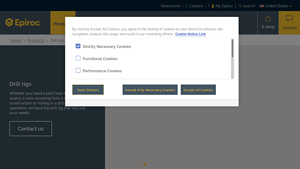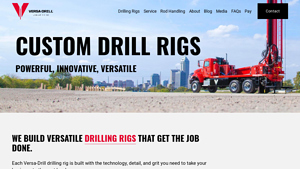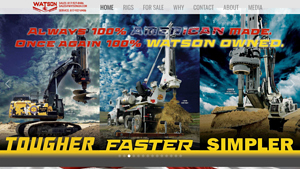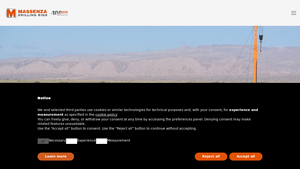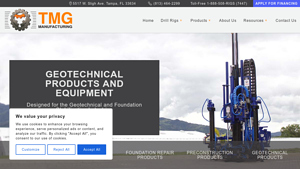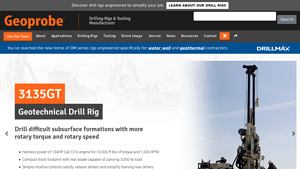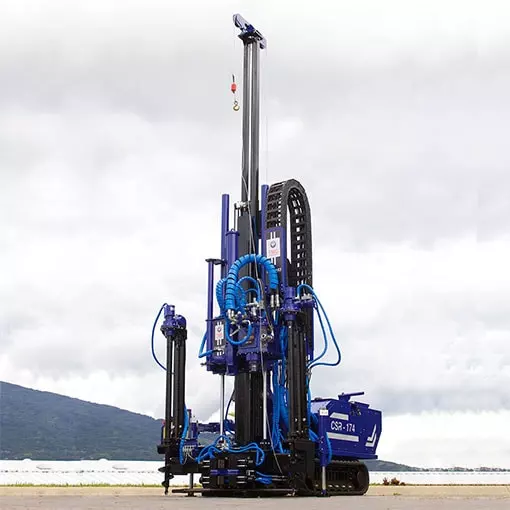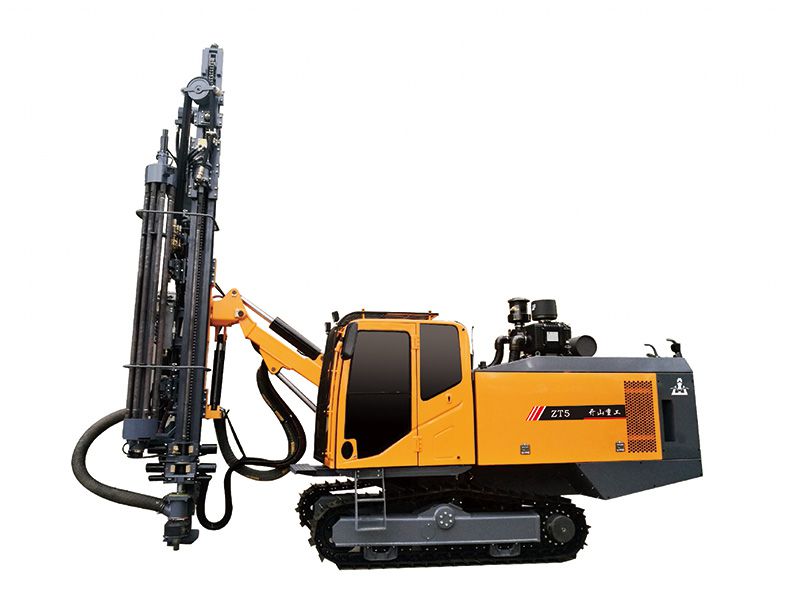Top 7 Drill Rig Manufacturer List and Guide
Top 7 Drill Rig Manufacturer Manufacturers & Suppliers List
1. Epiroc – Drill Rigs
Domain: epiroc.com
Registered: 2017 (8 years)
Introduction: Drill rigs offered by Epiroc include: Dimension stone equipment, Exploration drill rigs, Face drill rigs (Jumbos), Production drill rigs, Rotary blasthole drill rigs, and Surface drill rigs. Epiroc has been a leading manufacturer for 140 years, providing various solutions for mining, construction, and other applications.
2. Versa-Drill – Drilling Rigs
Domain: versa-drill.com
Registered: 2017 (8 years)
Introduction: Versa-Drill offers a range of drilling rigs including: Water Well Drilling Rigs, Air Rotary Drilling Rigs, Geothermal Drilling Rigs, Exploration Drilling Rigs, Cathodic Protection Drilling Rigs, Sonic Drilling Rigs, and Pre-Owned Drilling Rigs. Key models include: V-12 (12,000 lbs pullback), V-125X (25,000 lbs pullback), V-140X (40,000 lbs pullback), V-140TRX (40,000 lbs pullback), MARK50 (50,000 …
3. Watson – Customizable Hydraulic and Mechanical Drill Rigs
Domain: watsonusa.com
Registered: 1998 (27 years)
Introduction: Watson offers a range of customizable hydraulic and mechanical drill rigs designed for drilled shaft (bored pile) construction. The rigs are built rugged for proven field performance and high resale value. Available models include: 1030 TM/CM (30,000 ft-lb | 41 kNm), 1100 TM/CM (45,000 ft-lb | 61 kNm), 2200 TM (63,000 ft-lb | 85 kNm), 2500 TM/CM (90,000 ft-lb | 122 kNm), 3110 TM/CM (120,000 ft-lb …
4. Massenza Drilling Rigs – Versatile Drilling Solutions
Domain: massenzarigs.com
Registered: 2016 (9 years)
Introduction: Massenza Drilling Rigs manufactures a variety of drilling rigs suitable for multiple applications, including: 1. Geotechnical Drilling Rigs – for soil sampling, investigations, augers, percussion and rotary drilling, SPT tests, and coring. 2. Mineral Exploration Drilling Rigs – designed for mineral research and core drilling in mines, adaptable to depth, hole diameter, and soil type. 3. Seismic Dr…
5. TMG Manufacturing – Geotechnical Drill Rigs
Domain: tmgmfg.com
Registered: 2007 (18 years)
Introduction: TMG Manufacturing offers a range of geotechnical products and drilling rigs, including: 1. Multi-Purpose Drill Rigs 2. Geotechnical Drill Rigs 3. SPT and Coring Drill Rigs 4. CPT and DMT Test Rigs 5. Mini Geotechnical Drill Rigs 6. Micropile & Rotary Drill Rigs 7. CPT & SCPT Equipment 8. Compaction Grouting Products 9. Foundation Repair Products 10. Pre-Construction Products. The company manufactu…
6. Geoprobe Systems® – Sonic Drill Rigs
Domain: geoprobe.com
Registered: 1996 (29 years)
Introduction: Geoprobe Systems® offers a range of drilling rigs and tooling for various applications including geotechnical, environmental, exploration, water well, geothermal, and construction. Key products include:
1. **Sonic Drill Rigs**:
– 8250LS Sonic Drill Rig
– 8150LS Sonic Drill Rig
– SRC30DT
2. **Direct Push & Rotary Drill Rigs**:
– 3230DT Drill Rig
– 7822DT Drill Rig
3. **Geo…
7. RTDrill – Drilling Equipment Solutions
Domain: rtdrill.com
Registered: 2018 (7 years)
Introduction: RTDrill by Reichdrill offers a complete line of drilling equipment, including DTH drill rigs, rotary drill rigs, and truck-mounted drill rigs. The company specializes in manufacturing equipment for various industries such as water well, oil and gas exploration, quarrying, construction, and mining. They emphasize innovation in design to enhance productivity and cost-efficiency. Additionally, RTDril…
Introduction: Navigating the Global Market for drill rig manufacturer
In the ever-evolving landscape of global drilling operations, sourcing the right drill rig manufacturer can present a formidable challenge for B2B buyers. From Africa to South America, the Middle East to Europe, decision-makers face the critical task of identifying reliable partners that can deliver high-quality, versatile rigs tailored to their specific operational needs. This comprehensive guide is designed to empower international buyers by elucidating the diverse types of drill rigs available, their applications across various industries, and crucial factors to consider during the supplier vetting process.
Within these pages, you will find in-depth insights into the latest innovations in drilling technology, cost considerations, and the importance of after-sales support. By understanding the nuances of different rig models—whether for mining, construction, or environmental applications—purchasers can make informed decisions that align with their business objectives. Additionally, this guide addresses regional considerations, highlighting key market players and trends specific to regions such as Vietnam and Brazil, ensuring that you have the necessary context to navigate the complexities of international procurement.
Armed with this knowledge, B2B buyers will be better equipped to forge partnerships that not only meet immediate operational demands but also contribute to long-term business success in the competitive drilling sector.
Understanding drill rig manufacturer Types and Variations
| Type Name | Key Distinguishing Features | Primary B2B Applications | Brief Pros & Cons for Buyers |
|---|---|---|---|
| Surface Drill Rigs | Designed for open-air operations; high mobility | Mining, Construction, Quarrying | Pros: Versatile, easy to transport. Cons: Limited depth capability. |
| Underground Drill Rigs | Compact design for confined spaces; advanced safety features | Underground Mining, Tunneling | Pros: High precision, suitable for deep drilling. Cons: Higher operational costs. |
| Water Well Drill Rigs | Specialized for groundwater extraction; portable | Water Supply, Geothermal Projects | Pros: Effective for water sourcing, often compact. Cons: Limited to water-related applications. |
| Blasthole Drill Rigs | Heavy-duty for large diameter holes; high penetration rate | Mining, Quarrying | Pros: Efficient for large operations, robust construction. Cons: Requires skilled operators. |
| Sonic Drill Rigs | Utilizes sonic technology for rapid drilling; minimal disturbance | Environmental Sampling, Geotechnical | Pros: Reduced environmental impact, high accuracy. Cons: Often more expensive and requires specialized knowledge. |
What Are Surface Drill Rigs and Their Applications?
Surface drill rigs are characterized by their ability to operate in open-air environments, making them ideal for applications in mining, construction, and quarrying. These rigs are typically highly mobile, allowing for easy relocation between job sites. When considering a surface drill rig, buyers should evaluate factors such as transportability, power sources, and versatility in handling various drilling tasks. While they offer significant advantages in mobility and versatility, their limitations include a reduced capacity for deep drilling compared to other types.
How Do Underground Drill Rigs Differ in Features and Use?
Underground drill rigs are specifically designed for drilling in confined spaces, often featuring advanced safety mechanisms to protect operators. They are commonly used in underground mining and tunneling projects, where precision and safety are paramount. Buyers interested in underground rigs should focus on the rig’s size, depth capability, and safety features. While these rigs provide high accuracy and are suitable for deep drilling, they often come with higher operational costs and require specialized training for operators.
What Makes Water Well Drill Rigs Essential for Groundwater Extraction?
Water well drill rigs are specialized machines designed for the extraction of groundwater, often used in water supply and geothermal projects. Their portability makes them suitable for various locations, including rural areas. When purchasing a water well drill rig, buyers should assess the rig’s depth capabilities, ease of setup, and efficiency in drilling. While these rigs are effective for water sourcing, their applications are primarily limited to water-related projects, which may not meet the diverse needs of some buyers.
Why Are Blasthole Drill Rigs Critical in Mining Operations?
Blasthole drill rigs are built for heavy-duty applications, particularly in mining and quarrying, where they create large-diameter holes for blasting. These rigs are known for their high penetration rates and robust construction, making them suitable for demanding environments. Buyers should consider the rig’s durability, drilling speed, and compatibility with various drilling methods. Although they are efficient and effective for large-scale operations, they require skilled operators to maximize their potential.
What Advantages Do Sonic Drill Rigs Offer for Environmental Projects?
Sonic drill rigs utilize innovative sonic technology, allowing for rapid drilling with minimal environmental disturbance. They are particularly effective for environmental sampling and geotechnical investigations. Buyers should evaluate the rig’s technology, accuracy, and environmental impact capabilities. While sonic drill rigs offer high accuracy and reduced ecological footprint, they tend to be more expensive and may require specialized knowledge for operation, which can be a consideration for budget-conscious buyers.
Key Industrial Applications of drill rig manufacturer
| Industry/Sector | Specific Application of Drill Rig Manufacturer | Value/Benefit for the Business | Key Sourcing Considerations for this Application |
|---|---|---|---|
| Mining | Blasthole Drilling for Surface Mining | Enhances operational efficiency and reduces drilling time | Compatibility with local geological conditions, durability, and ease of maintenance |
| Construction | Foundation Drilling for High-Rise Buildings | Ensures structural integrity and compliance with regulations | Availability of specialized rigs for urban environments and rapid service support |
| Water Resource Management | Water Well Drilling | Provides access to clean water, essential for communities | Compliance with environmental regulations and local permits, as well as technology for water quality testing |
| Geothermal Energy | Geothermal Well Drilling | Supports sustainable energy initiatives and reduces costs | Expertise in thermal properties of the ground and efficiency of rig operations in various terrains |
| Environmental Remediation | Soil Sampling and Contamination Assessment | Facilitates environmental assessments and remediation efforts | Equipment adaptability for different soil types and support for compliance with environmental standards |
How is Drill Rig Manufacturing Applied in Mining?
In the mining sector, drill rigs are essential for blasthole drilling, which is critical for surface mining operations. These rigs are designed to penetrate various rock types efficiently, thereby enhancing operational productivity and reducing drilling time. International buyers must consider the compatibility of rigs with local geological conditions, the durability of equipment in harsh environments, and the ease of maintenance to ensure longevity and reliability.
What Role Do Drill Rigs Play in Construction?
In construction, drill rigs are primarily used for foundation drilling, particularly for high-rise buildings. This application is crucial for ensuring the structural integrity of buildings and compliance with local regulations. Buyers should look for specialized rigs that can operate effectively in urban environments, as well as suppliers that offer rapid service support to minimize downtime during critical construction phases.
How Do Drill Rigs Contribute to Water Resource Management?
Drill rigs play a vital role in water well drilling, providing communities with access to clean water. This application is particularly important in regions facing water scarcity. Buyers should ensure that the rigs comply with environmental regulations and local permits, as well as possess technology for water quality testing to ensure safe and sustainable water access.
Why Are Drill Rigs Important for Geothermal Energy?
In the geothermal energy sector, drill rigs are utilized for drilling geothermal wells, which are essential for tapping into sustainable energy sources. These rigs support initiatives aimed at reducing energy costs and promoting environmental sustainability. Buyers should prioritize equipment that offers expertise in assessing the thermal properties of the ground and demonstrates operational efficiency across various terrains.
How Do Drill Rigs Assist in Environmental Remediation?
Drill rigs are also employed in environmental remediation for soil sampling and contamination assessments. This application is crucial for facilitating environmental assessments and ensuring compliance with environmental standards. Buyers must consider the adaptability of the equipment to different soil types and the support provided by manufacturers for meeting regulatory requirements, ensuring effective remediation efforts.
3 Common User Pain Points for ‘drill rig manufacturer’ & Their Solutions
Scenario 1: Difficulty in Selecting the Right Drill Rig for Diverse Applications
The Problem: B2B buyers often face the challenge of selecting the appropriate drill rig for their specific application needs. With various rig types designed for different tasks—such as core sampling, water well drilling, or exploratory drilling—buyers may find it overwhelming to navigate the technical specifications and operational capabilities of each model. This uncertainty can lead to costly mistakes, such as purchasing equipment that is either too specialized or insufficient for their projects, ultimately impacting project timelines and budgets.
The Solution: To overcome this challenge, buyers should engage directly with drill rig manufacturers who offer expert consultation services. Before making a purchase, they should provide detailed information about their project requirements, including the geological conditions, the depth of drilling required, and the type of material being drilled. Manufacturers often have application specialists who can recommend the best rig for the job, taking into account factors like rig mobility, power source, and ease of maintenance. Additionally, prospective buyers should request demonstrations or trial periods to assess the rig’s performance in real-world scenarios, ensuring it meets their operational needs before committing to a purchase.
Scenario 2: Managing Maintenance and Downtime of Drill Rigs
The Problem: Another significant pain point for B2B buyers is the ongoing maintenance and potential downtime of drill rigs. Unplanned breakdowns can lead to significant delays and increased operational costs, particularly in remote locations where access to technical support is limited. Buyers often struggle to find reliable service options and may lack the in-house expertise to perform necessary repairs, leading to extended periods of inactivity that can jeopardize project deadlines.
The Solution: To mitigate maintenance-related challenges, buyers should prioritize manufacturers that offer comprehensive support services, including training for their operators and maintenance personnel. Buyers can also establish a proactive maintenance schedule based on the manufacturer’s recommendations, ensuring regular inspections and timely servicing of equipment. Furthermore, investing in drill rigs that feature modular components allows for easier on-site repairs, reducing the need for specialized mechanics. By building a strong relationship with the manufacturer and utilizing their support resources, buyers can enhance operational efficiency and minimize downtime.
Scenario 3: Challenges with Spare Parts Availability
The Problem: International buyers, particularly from regions such as Africa or South America, frequently encounter issues related to the availability of spare parts for their drill rigs. Delays in obtaining essential components can lead to extended downtimes, impacting overall project progress and incurring additional costs. This challenge is exacerbated by logistical issues, such as shipping delays and customs clearance, which can further prolong the time needed to resume operations.
The Solution: To address spare parts availability, buyers should work with manufacturers that offer comprehensive parts inventory and fast shipping options. Establishing a reliable communication channel with the manufacturer for quick ordering can significantly reduce lead times. Additionally, buyers should consider keeping a stock of critical spare parts on-site, tailored to their specific rig models and operational needs. This proactive approach ensures that common wear-and-tear components are readily available, allowing for immediate repairs and minimizing project interruptions. When negotiating contracts, buyers should also inquire about warranty and support services that include parts supply guarantees, ensuring they have access to necessary resources throughout the rig’s operational life.
Strategic Material Selection Guide for drill rig manufacturer
What Are the Key Materials Used in Drill Rig Manufacturing?
When selecting materials for drill rigs, manufacturers must consider a variety of factors that can affect performance, durability, and overall cost. Here, we analyze four common materials used in the industry: steel, aluminum, composite materials, and high-strength alloys. Each material has distinct properties, advantages, and limitations that can impact the rig’s functionality and suitability for specific applications.
How Does Steel Perform in Drill Rig Applications?
Key Properties: Steel is renowned for its high tensile strength and durability, making it suitable for heavy-duty applications. It typically has a temperature rating of up to 600°C and exhibits good pressure resistance, which is essential for drilling operations.
Pros & Cons: The primary advantage of steel is its robustness and longevity, which translates to lower maintenance costs over time. However, steel can be heavy, which may affect the mobility of the rig. Additionally, it is susceptible to corrosion, necessitating protective coatings or treatments, which can increase manufacturing complexity and costs.
Impact on Application: Steel is compatible with a wide range of media, including water, oil, and gas, making it versatile for various drilling operations. However, its weight may limit its use in remote or challenging terrains where mobility is crucial.
Considerations for International Buyers: Buyers from regions like Africa and South America should ensure compliance with local standards such as ASTM or DIN. Additionally, the availability of corrosion-resistant treatments may vary by region, impacting long-term performance.
What Are the Benefits of Aluminum in Drill Rig Construction?
Key Properties: Aluminum is lightweight yet strong, with a temperature rating of approximately 500°C. Its natural corrosion resistance is a significant advantage in harsh environments.
Pros & Cons: The key advantage of aluminum is its reduced weight, which enhances the rig’s portability and ease of transport. However, it is generally less durable than steel, making it less suitable for high-impact applications. The cost of aluminum can also be higher than standard steel, which may affect budget considerations.
Impact on Application: Aluminum is particularly effective in applications where weight is a critical factor, such as in portable drill rigs. Its corrosion resistance makes it ideal for drilling in coastal or humid environments.
Considerations for International Buyers: Buyers should be aware of the specific aluminum grades that meet international standards. Compliance with local regulations regarding material sourcing is also essential, especially in regions with strict environmental laws.
How Do Composite Materials Enhance Drill Rig Performance?
Key Properties: Composite materials, often made from a combination of fibers and resins, offer high strength-to-weight ratios and excellent corrosion resistance. They can withstand temperatures up to 300°C.
Pros & Cons: The primary advantage of composites is their lightweight nature, which significantly reduces the overall weight of the rig. However, they can be more expensive to manufacture and repair compared to traditional materials. Additionally, composites may not be suitable for high-stress applications due to their lower impact resistance.
Impact on Application: Composites are particularly beneficial in specialized drilling operations, such as geothermal drilling, where weight and corrosion resistance are paramount. Their compatibility with various media enhances their versatility.
Considerations for International Buyers: International buyers should ensure that composite materials meet local safety and performance standards. Understanding the supply chain for composite materials is crucial, as sourcing can vary significantly between regions.
What Role Do High-Strength Alloys Play in Drill Rig Design?
Key Properties: High-strength alloys, such as titanium or nickel-based alloys, provide exceptional strength and corrosion resistance, with temperature ratings exceeding 700°C.
Pros & Cons: The key advantage of high-strength alloys is their ability to withstand extreme conditions, making them ideal for specialized applications. However, they are typically much more expensive than steel or aluminum, and their manufacturing processes can be complex and time-consuming.
Impact on Application: These alloys are particularly suited for high-performance drilling applications, such as oil and gas exploration in extreme environments. Their durability ensures long-term reliability, reducing downtime.
Considerations for International Buyers: Buyers must consider the higher costs associated with high-strength alloys and ensure compliance with international standards. Additionally, sourcing these materials may be limited in certain regions, impacting availability.
Summary Table of Material Selection for Drill Rig Manufacturing
| Material | Typical Use Case for drill rig manufacturer | Key Advantage | Key Disadvantage/Limitation | Relative Cost (Low/Med/High) |
|---|---|---|---|---|
| Steel | Heavy-duty drilling operations | High durability and strength | Susceptible to corrosion | Medium |
| Aluminum | Portable and lightweight rigs | Lightweight and corrosion-resistant | Less durable than steel | High |
| Composite | Specialized drilling (e.g., geothermal) | High strength-to-weight ratio | More expensive and less impact-resistant | High |
| High-Strength Alloys | Extreme environment drilling | Exceptional strength and durability | High cost and complex manufacturing | High |
This strategic material selection guide serves as a comprehensive resource for international B2B buyers, enabling informed decisions that align with operational needs and regional considerations.
In-depth Look: Manufacturing Processes and Quality Assurance for drill rig manufacturer
What Are the Key Stages in the Manufacturing Process of Drill Rigs?
The manufacturing of drill rigs is a complex process that involves several critical stages. Understanding these stages is essential for B2B buyers, as it can significantly impact the quality and performance of the equipment they intend to purchase.
-
Material Preparation
The first stage involves sourcing high-quality raw materials, typically steel and alloys, that meet the specific requirements for strength and durability. These materials undergo rigorous testing to ensure they comply with international standards such as ASTM and ISO. Additionally, suppliers often conduct metallurgical analysis to assess the chemical composition, which is crucial for the operational efficiency of the drill rigs. -
Forming
Once the materials are prepared, the next step is forming, where the raw materials are shaped into components through processes such as machining, bending, and welding. Advanced technologies, including CNC machining and robotic welding, are often employed to ensure precision and consistency. This stage is critical, as even minor inaccuracies can lead to performance issues in the final product. -
Assembly
After forming, the components are assembled into the final drill rig. This process may involve both manual labor and automated systems, depending on the complexity of the rig. The assembly stage is where individual parts are integrated, and this often includes the installation of hydraulic systems, electronic controls, and other essential components. Quality checks are typically performed at this stage to catch any discrepancies before moving on. -
Finishing
The finishing stage includes surface treatments such as painting, galvanizing, or powder coating, which enhance durability and resistance to environmental factors. This stage also involves final inspections and testing to ensure that the drill rig meets all specifications and quality standards.
How Is Quality Assurance Implemented in Drill Rig Manufacturing?
Quality assurance (QA) is integral to the manufacturing process of drill rigs, ensuring that each unit produced meets stringent quality and performance criteria. B2B buyers should pay close attention to the quality assurance practices employed by their suppliers.
-
What International Standards Are Relevant for Drill Rig Manufacturers?
Compliance with international standards is crucial for establishing trust and reliability in the manufacturing process. ISO 9001 is a widely recognized standard that outlines the requirements for a quality management system (QMS). Manufacturers often pursue certification to demonstrate their commitment to quality. Additionally, industry-specific standards such as CE marking for European markets and API (American Petroleum Institute) standards for oil and gas applications ensure that products meet safety and performance benchmarks. -
What Are the Key Quality Control Checkpoints in Drill Rig Manufacturing?
Quality control (QC) checkpoints are strategically placed throughout the manufacturing process:
– Incoming Quality Control (IQC): This initial checkpoint involves inspecting raw materials upon arrival to ensure they meet specified standards.
– In-Process Quality Control (IPQC): Conducted during the manufacturing process, this checkpoint assesses components at various stages to catch defects early.
– Final Quality Control (FQC): This final assessment occurs after assembly and finishing, where the complete drill rig undergoes thorough testing and inspection to ensure it meets all quality standards before delivery. -
What Common Testing Methods Are Used in Drill Rig Manufacturing?
Several testing methods are employed to verify the performance and safety of drill rigs. These may include:
– Hydraulic Testing: Ensures that hydraulic systems function correctly under pressure.
– Load Testing: Assesses the structural integrity of the rig when subjected to operational loads.
– Functional Testing: Confirms that all systems operate as intended, including control systems and safety features.
How Can B2B Buyers Verify Supplier Quality Control Practices?
For international B2B buyers, particularly from regions such as Africa, South America, the Middle East, and Europe, verifying a supplier’s quality control practices is essential to ensure product reliability.
-
What Are the Best Practices for Conducting Supplier Audits?
Conducting supplier audits is one of the most effective ways to assess quality control practices. Buyers should request documentation of the supplier’s quality management system, including their processes for IQC, IPQC, and FQC. Additionally, on-site audits can provide insights into the manufacturing environment and adherence to safety and quality standards. -
How Important Are Quality Assurance Reports?
Quality assurance reports, including inspection and test results, should be available upon request. These documents provide transparency regarding the manufacturing process and can help buyers identify any potential issues before placing orders. -
What Role Do Third-Party Inspections Play in Quality Assurance?
Engaging third-party inspection agencies can add an additional layer of verification. These independent organizations conduct audits and inspections to ensure that manufacturers comply with industry standards and customer specifications. This practice is particularly beneficial for international buyers who may not be able to visit the manufacturing site.
What Nuances Should International B2B Buyers Be Aware of Regarding Quality Control?
International buyers must navigate various nuances in quality control that can affect their purchasing decisions. Understanding these aspects can help mitigate risks and ensure successful transactions.
-
Cultural and Regional Differences
Quality expectations can vary significantly between regions. Buyers should familiarize themselves with local standards and practices to ensure alignment with their own quality requirements. For instance, European standards might be more stringent compared to those in other regions. -
Logistics and Supply Chain Considerations
The logistics of transporting drill rigs can impact their quality. Buyers should discuss packaging and shipping methods with suppliers to ensure that the products arrive in optimal condition. Additionally, understanding lead times and potential delays can help buyers plan their projects more effectively. -
After-Sales Support and Warranty
Buyers should also consider the supplier’s after-sales support and warranty policies. A robust support system can help address any quality issues that arise post-purchase, ensuring that the buyer’s operations remain uninterrupted.
By understanding the manufacturing processes and quality assurance practices of drill rig manufacturers, B2B buyers can make informed decisions that align with their operational needs and quality standards.
Practical Sourcing Guide: A Step-by-Step Checklist for ‘drill rig manufacturer’
Introduction
This practical sourcing guide is designed to help B2B buyers effectively procure drill rigs from manufacturers. With the diverse applications of drill rigs across industries such as construction, mining, and geothermal energy, it’s essential to have a structured approach to sourcing. This checklist will ensure you make informed decisions that align with your operational needs and budget constraints.
Step 1: Define Your Technical Specifications
Before initiating contact with manufacturers, clearly outline your technical requirements. Consider the type of drilling application—whether it’s for water wells, exploration, or construction—and the specific features needed, such as depth capacity and mobility. Having precise specifications helps in filtering manufacturers that can meet your operational demands.
Step 2: Research Potential Manufacturers
Conduct thorough research to identify leading drill rig manufacturers. Look for companies with a proven track record and extensive experience in the industry. Resources such as trade publications, industry forums, and online directories can provide insights into potential suppliers and their reputations.
Step 3: Evaluate Supplier Certifications
Verify that your shortlisted manufacturers hold relevant certifications and comply with industry standards. Certifications, such as ISO or equipment safety standards, indicate a commitment to quality and safety. Ensure that the manufacturer’s processes align with international regulations, especially if you are sourcing for projects in diverse regions like Africa or Europe.
Step 4: Request Detailed Proposals
Once you have identified potential suppliers, request comprehensive proposals that include pricing, delivery timelines, and warranty information. A detailed proposal should outline the specifications of the rigs offered, including any customization options. Pay attention to the total cost of ownership, which includes maintenance and operational costs, not just the initial purchase price.
Step 5: Conduct Site Visits or Virtual Tours
If possible, arrange site visits to the manufacturer’s facilities or request virtual tours. Observing the manufacturing process provides insight into the quality control measures in place. During these visits, assess the equipment used and the overall organization of the production facility to gauge their operational efficiency.
Step 6: Check Customer References and Reviews
Before finalizing your decision, ask for references from previous clients, particularly those in your industry or region. Customer testimonials can provide valuable insights into the manufacturer’s reliability and customer service. Look for reviews or case studies that highlight the manufacturer’s ability to meet deadlines and their responsiveness to issues.
Step 7: Negotiate Terms and Finalize the Contract
Once you’ve chosen a supplier, it’s time to negotiate terms. Discuss payment options, delivery schedules, and after-sales support. A well-defined contract should include all agreed-upon specifications, warranties, and service agreements to protect your investment and ensure a smooth procurement process.
By following these steps, you can streamline your sourcing process and select a drill rig manufacturer that meets your operational needs, ensuring a successful partnership for your projects.
Comprehensive Cost and Pricing Analysis for drill rig manufacturer Sourcing
What are the Key Cost Components in Drill Rig Manufacturing?
Understanding the cost structure of drill rig manufacturing is crucial for B2B buyers, especially when sourcing from international markets. The primary cost components include materials, labor, manufacturing overhead, tooling, quality control (QC), logistics, and profit margins.
-
Materials: The choice of materials significantly impacts the overall cost. High-strength steel, specialized alloys, and advanced composites can enhance durability and performance but may increase the price. Additionally, sourcing materials locally versus internationally can affect costs due to fluctuating tariffs and shipping fees.
-
Labor: Labor costs vary widely based on the geographical location of the manufacturing facility. In regions with lower labor costs, such as parts of South America and Africa, manufacturers may offer more competitive pricing. However, it’s essential to consider the skill level and experience of the workforce, as this can influence the quality of the final product.
-
Manufacturing Overhead: This includes expenses related to the facility, utilities, equipment maintenance, and administrative costs. Efficient production processes can help minimize overhead, ultimately reducing the price passed on to buyers.
-
Tooling: The initial investment in specialized tooling for manufacturing specific drill rig types can be substantial. Custom tooling designed for unique specifications may lead to higher upfront costs but can improve production efficiency and quality.
-
Quality Control (QC): Rigorous QC processes are essential for ensuring safety and reliability in drill rigs. The costs associated with QC can vary depending on the complexity of the product and the certifications required (e.g., ISO standards).
-
Logistics: Transporting heavy machinery like drill rigs involves significant logistical considerations. Shipping costs can fluctuate based on distance, mode of transport, and any applicable tariffs. Understanding Incoterms is crucial for international buyers to clarify responsibilities for shipping and handling.
-
Margin: Manufacturers typically include a profit margin in their pricing, which can vary based on market demand and competitive pressures. Buyers should be aware that higher quality and specialized rigs often command higher margins.
How Do Price Influencers Affect Drill Rig Costs?
Several factors can influence the pricing of drill rigs beyond the basic cost components.
-
Volume and Minimum Order Quantity (MOQ): Buyers often receive better pricing when purchasing in bulk. Negotiating MOQs can lead to significant savings, especially for companies planning long-term projects.
-
Specifications and Customization: Highly customized rigs tailored to specific applications can significantly increase costs. Buyers should consider whether standard models can meet their needs to avoid unnecessary expenses.
-
Quality and Certifications: The level of quality assurance and the certifications held by the manufacturer can affect pricing. Rigs that meet international standards may carry a premium, but they often provide better reliability and lower Total Cost of Ownership (TCO).
-
Supplier Factors: Relationships with suppliers can play a crucial role in pricing negotiations. Long-standing partnerships may lead to favorable terms and pricing based on trust and reliability.
What Are Some Effective Buyer Tips for Negotiating Drill Rig Prices?
When sourcing drill rigs, particularly for international projects, buyers should keep several strategies in mind:
-
Negotiate Wisely: Leverage your purchasing power by negotiating terms, prices, and payment schedules. Understanding the supplier’s cost structure can provide leverage during negotiations.
-
Focus on Cost-Efficiency: Evaluate the Total Cost of Ownership (TCO) rather than just the upfront price. Consider maintenance, operational efficiency, and resale value when assessing the overall investment.
-
Understand Pricing Nuances: Different regions may have unique pricing structures influenced by local market conditions, currency fluctuations, and economic factors. Being aware of these nuances can help buyers make informed decisions.
-
Seek Multiple Quotes: Don’t settle for the first offer. Gathering multiple quotes can provide insight into market pricing and help identify the best value.
-
Consider Incoterms: Familiarize yourself with Incoterms to clarify shipping responsibilities and potential costs. This understanding can prevent unexpected expenses and delays in the supply chain.
In conclusion, a comprehensive understanding of the cost components and pricing influencers in drill rig manufacturing can empower B2B buyers to make informed decisions, negotiate effectively, and ultimately optimize their procurement strategies.
Alternatives Analysis: Comparing drill rig manufacturer With Other Solutions
Understanding Alternatives to Drill Rig Manufacturers
In the world of drilling operations, selecting the right equipment is crucial for efficiency and effectiveness. While traditional drill rig manufacturers provide robust solutions, several alternative methods and technologies can also meet the diverse needs of B2B buyers, particularly in sectors such as construction, mining, and environmental drilling. This analysis compares drill rig manufacturers with alternative solutions, helping buyers make informed decisions based on their specific operational requirements.
Comparison Table
| Comparison Aspect | Drill Rig Manufacturer | Alternative 1: Portable Drilling Systems | Alternative 2: Sonic Drilling Technology |
|---|---|---|---|
| Performance | High precision and depth capacity | Moderate precision, limited depth | High precision, ideal for soft soils |
| Cost | Higher initial investment | Lower upfront cost, variable expenses | Moderate to high cost, quick ROI |
| Ease of Implementation | Requires trained personnel | Easy setup, minimal training needed | Requires specialized training |
| Maintenance | Regular maintenance needed | Low maintenance, user-friendly design | Regular checks needed, specialized parts |
| Best Use Case | Deep drilling in hard rock | Shallow wells, quick projects | Environmental sampling and remediation |
Exploring Portable Drilling Systems as an Alternative
Portable drilling systems offer a compelling alternative to traditional drill rigs, particularly for projects that require flexibility and mobility. These systems are designed for ease of transport and quick setup, making them suitable for shallow drilling applications like water wells and geothermal projects. The initial investment is generally lower than that of conventional rigs, but users may encounter variable costs related to site preparation and operational logistics. However, their performance may be limited in terms of depth and precision compared to dedicated drill rig solutions.
Analyzing Sonic Drilling Technology
Sonic drilling technology represents another innovative alternative, especially beneficial for environmental applications. This method utilizes high-frequency vibrations to penetrate soil and rock, allowing for rapid drilling without the need for drilling fluids. Sonic rigs are particularly effective in soft soils and are ideal for environmental sampling and remediation projects. While the cost of sonic drilling equipment can be moderate to high, the quick return on investment through reduced time and labor costs often justifies the expense. However, this technology requires specialized training for operators, which can be a barrier for some organizations.
Conclusion: Choosing the Right Drilling Solution
When selecting a drilling solution, B2B buyers must carefully evaluate their specific operational needs, budget constraints, and the nature of their projects. While traditional drill rig manufacturers offer robust and reliable equipment for deep and precise drilling, alternatives like portable drilling systems and sonic drilling technology can provide significant advantages in flexibility and efficiency for particular applications. By understanding the strengths and weaknesses of each option, buyers can make informed decisions that align with their project goals and operational capabilities, ensuring optimal performance and cost-effectiveness in their drilling operations.
Essential Technical Properties and Trade Terminology for drill rig manufacturer
What Are the Essential Technical Properties of Drill Rigs?
Understanding the technical specifications of drill rigs is crucial for B2B buyers to make informed purchasing decisions. Here are several key properties that significantly impact performance and efficiency:
1. Material Grade
The material used in constructing drill rigs, often high-strength steel or specialized alloys, is vital for durability and resistance to wear. High-grade materials ensure that rigs can withstand harsh operational environments and heavy workloads, which is essential for long-term investment in drilling equipment.
2. Tolerance Levels
Tolerance refers to the allowable deviation from specified dimensions in the manufacturing process. High tolerance levels are crucial in drilling applications to ensure precision and efficiency. Equipment with tight tolerances results in better performance and reduces the risk of operational failures, leading to cost savings in maintenance and downtime.
3. Weight Capacity
The weight capacity of a drill rig indicates the maximum load it can handle. This specification is critical for B2B buyers as it determines the rig’s suitability for specific projects, whether for mining, construction, or environmental drilling. Ensuring the rig can handle the expected load without compromising safety or performance is essential for successful operations.
4. Power Output
Power output, typically measured in horsepower or kilowatts, directly affects a drill rig’s efficiency and speed. A higher power output enables faster drilling rates and the ability to penetrate tougher materials, which is a significant advantage in competitive markets. Buyers should evaluate their operational needs to select a rig that offers the appropriate power for their applications.
5. Mobility and Configuration
The mobility of a drill rig, whether it’s a truck-mounted, trailer-mounted, or crawler-type rig, influences its deployment in various terrains and job sites. Configurable rigs that can adapt to different drilling techniques enhance versatility, allowing operators to tackle diverse projects without requiring multiple machines.
What Are Common Trade Terms in the Drill Rig Industry?
Familiarity with industry jargon is essential for effective communication and negotiation in the B2B landscape. Here are some commonly used terms in the drill rig manufacturing sector:
1. OEM (Original Equipment Manufacturer)
OEM refers to companies that produce equipment or components that are sold under another company’s brand name. In the drill rig industry, partnering with an OEM can ensure high-quality components and reliable performance, as these manufacturers are often recognized for their expertise and innovation.
2. MOQ (Minimum Order Quantity)
MOQ is the smallest number of units a supplier is willing to sell. Understanding MOQ is crucial for buyers to manage inventory costs and production schedules effectively. It can influence purchasing decisions, especially for smaller companies or projects with limited budgets.
3. RFQ (Request for Quotation)
An RFQ is a formal document issued by a buyer to solicit price quotes from suppliers. In the context of drill rigs, submitting an RFQ helps buyers compare prices and terms, ensuring they receive competitive offers. This process is essential for budget management and securing the best value.
4. Incoterms (International Commercial Terms)
Incoterms are internationally recognized rules that define the responsibilities of buyers and sellers in shipping goods. Understanding these terms is vital for B2B buyers to clarify shipping costs, insurance, and risk management, particularly when sourcing drill rigs from international manufacturers.
5. Lead Time
Lead time refers to the time it takes from placing an order until the product is delivered. In the drill rig industry, lead time can vary significantly based on customization and manufacturing processes. Buyers should factor in lead times to align with project timelines and avoid delays in operations.
Conclusion
Having a solid grasp of the essential technical properties and trade terminology related to drill rig manufacturing empowers B2B buyers to make strategic decisions. By understanding these specifications and terms, businesses can enhance their procurement processes, ensuring they select the right equipment for their operational needs.
Navigating Market Dynamics and Sourcing Trends in the drill rig manufacturer Sector
What Are the Key Market Dynamics and Sourcing Trends for Drill Rig Manufacturers?
The global market for drill rig manufacturing is shaped by several key drivers, including technological advancements, increasing demand for natural resources, and evolving regulations. Emerging technologies such as automation and digitalization are enhancing operational efficiency and safety, making drill rigs more versatile and capable of tackling complex tasks across various sectors, including mining, construction, and geothermal energy. In regions like Africa and South America, the exploration and extraction of resources are paramount, driven by both domestic needs and international demand. The Middle East, with its significant oil reserves, continues to invest in advanced drilling technologies to improve extraction methods, while Europe focuses on sustainable practices and energy transition.
International B2B buyers are increasingly prioritizing suppliers who offer innovative and customizable solutions tailored to specific regional needs. For instance, in areas prone to extreme weather conditions or varied geological structures, drill rigs that can adapt to these challenges are essential. Moreover, the rise of remote monitoring technologies allows for better management of drilling operations, providing real-time data that can enhance decision-making processes and reduce downtime.
How Are Sustainability and Ethical Sourcing Influencing the Drill Rig Manufacturing Sector?
Sustainability has become a critical consideration for B2B buyers in the drill rig sector. The environmental impact of drilling operations is significant, prompting companies to adopt more sustainable practices. This shift includes the use of eco-friendly materials and energy-efficient technologies in the manufacturing process. Buyers are increasingly looking for manufacturers that demonstrate a commitment to reducing carbon footprints and minimizing waste.
Ethical sourcing is another crucial aspect of this trend. Buyers are more inclined to partner with manufacturers who ensure their supply chains are free from unethical practices. This includes the use of responsibly sourced materials and adherence to labor standards. Certifications such as ISO 14001 for environmental management and adherence to the United Nations Sustainable Development Goals can serve as indicators of a manufacturer’s commitment to sustainability. By prioritizing these factors, B2B buyers can not only enhance their corporate responsibility profiles but also align with global trends toward environmental stewardship.
How Has the Drill Rig Manufacturing Industry Evolved Over Time?
The drill rig manufacturing industry has undergone significant transformations since its inception, driven by technological advancements and changing market demands. Initially focused on manual operations, the sector has evolved to incorporate automation and advanced engineering techniques. Over the last century, innovations such as hydraulic systems and computer-controlled drilling rigs have emerged, greatly enhancing efficiency and precision.
The historical context of drill rig manufacturing reveals a trend toward specialization, with manufacturers now offering a wide array of rig types tailored for specific applications, from oil and gas extraction to geothermal energy and construction. This evolution reflects a broader trend in the B2B landscape, where customization and adaptability have become essential for meeting the diverse needs of international buyers. As the industry continues to evolve, manufacturers are expected to further innovate, focusing on sustainability and technological integration to meet the demands of a dynamic global market.
Frequently Asked Questions (FAQs) for B2B Buyers of drill rig manufacturer
-
How do I determine the right drill rig for my specific application?
Selecting the appropriate drill rig depends on several factors, including the type of drilling (e.g., water well, geothermal, or exploration), soil conditions, and project scale. Begin by assessing your project requirements and consider consulting with manufacturers who specialize in your industry. They can provide insights on the best rig features, such as size, mobility, and technological capabilities, ensuring you invest in equipment that maximizes efficiency and productivity. -
What are the customization options available when purchasing drill rigs?
Many drill rig manufacturers offer customizable solutions to meet unique project needs. Customization may include adjustments to rig specifications, such as drill depth, power sources, or additional attachments for specific tasks. When discussing options with a supplier, be clear about your requirements and ask for examples of previous custom projects to gauge their expertise and flexibility in delivering tailored solutions. -
What is the minimum order quantity (MOQ) for drill rigs?
Minimum order quantities can vary significantly among manufacturers. Some may have a standard MOQ for production runs, while others might allow for single-unit purchases, especially for customized rigs. It’s advisable to clarify MOQs during initial discussions with suppliers and explore potential for bulk purchasing discounts if you anticipate needing multiple rigs over time. -
What payment terms should I expect when buying drill rigs internationally?
Payment terms can differ by supplier and region. Typically, manufacturers may require a deposit upfront (often 30% to 50%), with the balance due upon delivery or installation. Additionally, international transactions may involve letters of credit or escrow services to ensure security for both parties. Always review payment terms carefully and negotiate to find a mutually agreeable solution that minimizes financial risk. -
How can I assess the quality assurance processes of a drill rig manufacturer?
To evaluate a manufacturer’s quality assurance (QA) processes, request information on their certifications, such as ISO standards, and inquire about their testing procedures for drill rigs. Look for suppliers that provide detailed documentation of their QA protocols, including inspections and performance testing. Additionally, customer reviews and case studies can provide insights into their reliability and the durability of their products in real-world applications. -
What logistics considerations should I keep in mind when importing drill rigs?
When importing drill rigs, consider factors such as shipping methods, customs regulations, and delivery timelines. Discuss logistics with your supplier to understand their shipping options and whether they handle customs clearance. It’s also important to factor in potential delays due to international shipping and ensure you have a robust plan for transporting the rigs to your project site once they arrive. -
What are the typical lead times for manufacturing and delivering drill rigs?
Lead times for drill rig manufacturing and delivery can vary based on the complexity of the rig, customization requirements, and the manufacturer’s production capacity. Standard lead times may range from a few weeks to several months. Always request a detailed timeline from the supplier during negotiations and factor this into your project planning to avoid delays in operations. -
How do I verify the reputation and reliability of a drill rig manufacturer?
To verify a manufacturer’s reputation, conduct thorough research by reviewing customer testimonials, industry certifications, and case studies of previous projects. Networking with other businesses in your sector can provide valuable feedback on their experiences with specific suppliers. Additionally, attending industry trade shows or exhibitions can help you meet manufacturers in person and assess their capabilities firsthand.
Important Disclaimer & Terms of Use
⚠️ Important Disclaimer
The information provided in this guide, including content regarding manufacturers, technical specifications, and market analysis, is for informational and educational purposes only. It does not constitute professional procurement advice, financial advice, or legal advice.
While we have made every effort to ensure the accuracy and timeliness of the information, we are not responsible for any errors, omissions, or outdated information. Market conditions, company details, and technical standards are subject to change.
B2B buyers must conduct their own independent and thorough due diligence before making any purchasing decisions. This includes contacting suppliers directly, verifying certifications, requesting samples, and seeking professional consultation. The risk of relying on any information in this guide is borne solely by the reader.
Strategic Sourcing Conclusion and Outlook for drill rig manufacturer
How Can Strategic Sourcing Enhance Your Drill Rig Procurement?
In the competitive landscape of drill rig manufacturing, strategic sourcing emerges as a vital approach for international buyers. By carefully evaluating suppliers based on quality, innovation, and support services, companies can secure equipment that not only meets immediate operational needs but also fosters long-term sustainability and efficiency. Key takeaways include the importance of selecting versatile and user-friendly rigs, as well as the value of strong after-sales support that can reduce downtime and enhance productivity.
Furthermore, as markets in Africa, South America, the Middle East, and Europe evolve, buyers must remain proactive in identifying suppliers that embrace the latest technological advancements, such as automation and eco-friendly practices. This alignment with modern trends will not only improve operational performance but also contribute to a more sustainable future.
As you navigate your sourcing decisions, consider leveraging partnerships with manufacturers who prioritize customization and customer-centric solutions. Embrace this opportunity to elevate your drilling operations and stay ahead in a rapidly changing industry. Engage with leading drill rig manufacturers today to explore how strategic sourcing can drive your business success.
